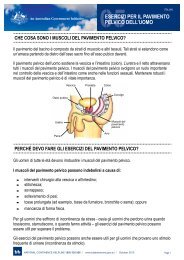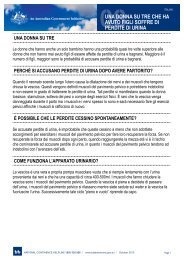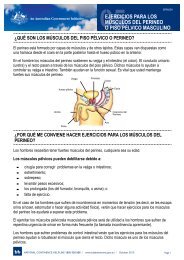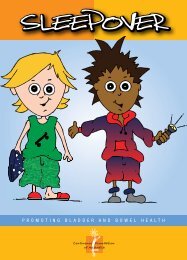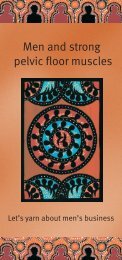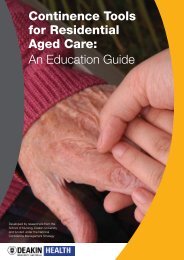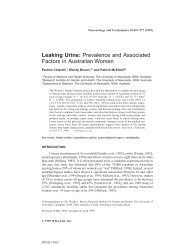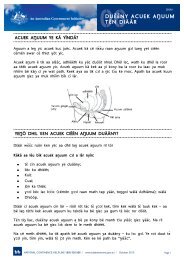Pharmacy Continence Care - Bladder and Bowel Website
Pharmacy Continence Care - Bladder and Bowel Website
Pharmacy Continence Care - Bladder and Bowel Website
You also want an ePaper? Increase the reach of your titles
YUMPU automatically turns print PDFs into web optimized ePapers that Google loves.
obtained 18 consumers’ consent to contact re case study interviews. A number have been<br />
available on followup call.<br />
Given the very small number of respondents in both the baseline (n=45) <strong>and</strong> follow-up<br />
(n=30) surveys, <strong>and</strong> the use of a mixed survey methodology (baseline survey completed in a<br />
retail or environment, <strong>and</strong> follow-up survey conducted by telephone with the respondents in<br />
their own homes), there are considerable constraints in the conclusions that can be drawn<br />
from the data. The study nevertheless provides some valuable information about the<br />
attitudes <strong>and</strong> behaviours of people suffering from incontinence <strong>and</strong> their carers, including<br />
the following:<br />
• Hygiene is the most common area hindering the physical health of those who are<br />
incontinent, followed by rashes, skin problems/skin breakdown <strong>and</strong><br />
infections/ulcerations.<br />
• <strong>Care</strong>rs are spending more time on washing bedding <strong>and</strong> clothing as a result of accidental<br />
urine loss or leakage from the bowel.<br />
• Disposable pads (either sanitary or incontinence) are the most commonly utilised product<br />
for incontinence sufferers.<br />
• Expenditure of continence care products (such as non-drug related products, skin care<br />
products <strong>and</strong> women’s sanitary products) is most commonly under $10 per week or<br />
between $10-$25 per week.<br />
• Brochure/pamphlets are the most commonly recalled type of information received from<br />
pharmacies.<br />
• People with incontinence, <strong>and</strong> those caring for people with incontinence, are generally<br />
not embarrassed to speak with pharmacy staff about incontinence.<br />
• For the majority, pharmacies are a comfortable place to discuss personal needs.<br />
Demographics<br />
Thirty-nine female <strong>and</strong> six male respondents participated in the baseline survey, <strong>and</strong> 24<br />
females <strong>and</strong> six males in the follow-up survey. The average age of respondents completing<br />
the baseline survey was 72.4 years, compared with 73.4 in the follow-up survey.<br />
In the baseline survey, excluding carers, there were 36 respondents with incontinence, with<br />
an average age of 70.9 years. In the follow-up survey, nine respondents stated they were<br />
carers of someone with incontinence. In the baseline survey, this was not directly elicited,<br />
although responses to Q3 suggest that 19 respondents were carers. The average age of the<br />
21 respondents with incontinence in the follow-up survey was 71.1 years.<br />
On average, respondents participating in the baseline survey indicated they had experienced<br />
incontinence for 10.2 years, <strong>and</strong> of those respondents who participated in the follow-up<br />
survey, incontinence had been experienced for an average of 12.8 years.<br />
4.3.1 Summary of findings from consumer surveys<br />
Health <strong>and</strong> wellbeing<br />
To assess the impact of incontinence on the participating consumer, an internationally used<br />
<strong>and</strong> validated instrument, the Incontinence Impact Questionnaire, Short Form (IIQ-7) was<br />
recommended by members of the NOVA Expert Panel <strong>and</strong> was researched by the project<br />
team. Correspondence with the owners of the intellectual property for the IIQ, Wake Forest<br />
University School of Medicine, Women’s Health Center of Excellence, Winston-Salem, North<br />
Carolina, confirmed availability of the instrument <strong>and</strong> a license fee was paid. The IIQ<br />
Final Report<br />
39<br />
NOVA Public Policy<br />
<strong>Pharmacy</strong> <strong>Continence</strong> <strong>Care</strong> Project



